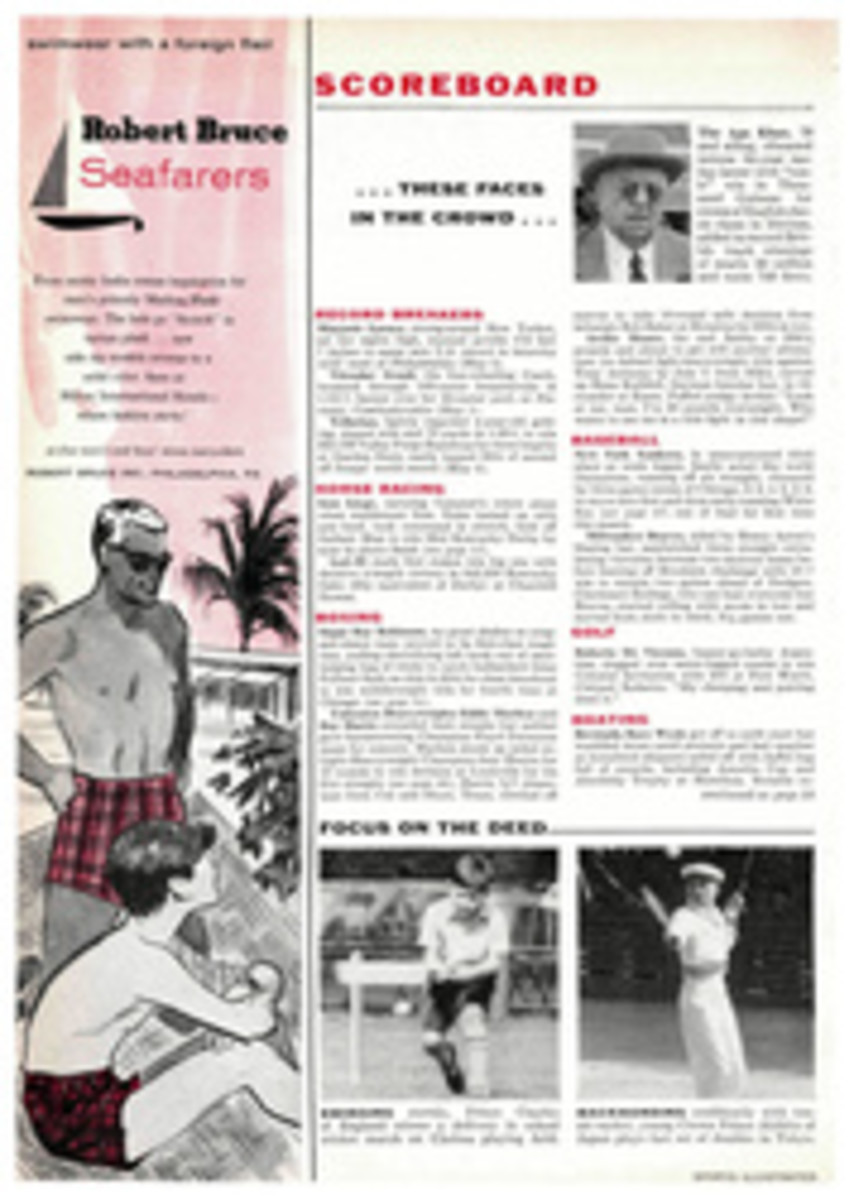
THE FOOTLOOSE SPORTSMAN in CHAMONIX
Deep in the French Alps, two hours from Geneva and hard by the Italian border which lies over the big hills, is the small gray village of Chamonix, a French resort dropped at the bottom of the canyonesque walls of the Haute Savoie like a peanut stand on the curb of Wall Street. In the winter Chamonix is a winter resort, in the summer it is a summer resort, but in the spring it is the last redoubt of the diehard skier fighting the onrushing warm waves of summer that have already dissolved the white-broadloom lesser slopes into rushing spring brooks. But the Chamonix skier who stays on long after the casino and a full third of the hotels have closed at the end of the winter season will find skiing possible on the western slopes at least until the end of April, and snow on the massive east wall that includes Mont Blanc itself until July. And if he tries it, he will find it is a type of skiing he will not soon forget.
For in the cloudland of these skyscraping peaks, as detailed in the previous pages, he will find adventure on the boards of a very high order indeed. The télépherique to the Aiguille du Midi carries its tiny cars to the 12,588-foot level on what has been called the world's most daring cable car ride. It is also the world's highest. A télécabin goes onward to the Col du Géant at 11,053 feet, and from here the spring skier can cover the boards with sealskin and tramp across the Vallée Blanche and down a snow-covered sea of ice known indeed as La Mer de Glace. La Mer can also be reached with somewhat less personal effort on the electric mountain railway that calls at the H√¥tel du Montenvers, an inn for goats, stuck in the crags 14 kilometers north of the Aiguille du Midi. The inn is open from the beginning of May to September. By next year another télécabin will connect with the present final station at Col du Géant and take passengers over the ridge and across the border into Italy.
Another télépherique will lift the late-season slatman at the rate of eight meters (3 feet 3 inches) a second to the heights of La Flég√®re (6,206 feet), a sunny base for ascents into the higher reaches. Bunk rooms in dormitories are available at about $5 a day with all meals, and for the day tripper who prefers to come up each morning, there are a restaurant and a self-service cafeteria where a skier can load his tray with saucisson, Brie, chunks of bread and a bottle of wine, take it out to the open-air terrace and eat in full view of the massive 12,000-foot peaks across the valley.
From the station at La Flég√®re, a télécabin, a lift which elevates the skier in tiny cabins each of which holds two, rides the cables up to L'Index at 7,874 feet. Here the air is brilliant, the sun is hot and the snow is patchy but skiable from L'Index down to La Flég√®re. Still another télépherique ascends the same wall to Le Brevent at 8,284 feet.
With its complex of lifts and tows scaling the giant walls that surround it, Chamonix's spring and summer skiing is especially good in the mornings. In the afternoon when the snow is soft the télépheriques bring the visitors down to earth for a round of golf on the nine-hole course (soon to be expanded) or for fishing in the river Arve (salmon trout and rainbow). The skating rink is open the year round, and in the afternoon the gliders skim over the surface under a billowing canvas awning spread over the arena to keep off the sun. Experts come from all over Europe to work in the early morning hours and there are open-air hockey games in July and August while bathers splatter in the artificial swimming pool a few yards away.
Chamonix, wounded in the war, has never been fully rehabilitated. It suffers from the competition of ultrachic Még√®ve which has no spring skiing, from Val d'Is√®re which does, and from such upstarts as Cour Cheval, a new French station 92 miles from Grenoble. Among the hotels down in the valley the choice has pretty much narrowed to the H√¥tel des Alpes, located between the highway and the river, and to the gently aging Savoy, tucked against a hillside away from the hurly-burly. The H√¥tel des Alpes put most of its improvements in the back of the house, added bathrooms and now has 50 for its 100 rooms. It charges about $8 a day in the slow spring season, plus 25% for tips and taxes. In summer the tab goes up another $1.50. The Savoy, with its residential atmosphere and rather faded finery, is run with a sort of quiet aristocratic air by Armand Tairraz, whose mother built it 50 years ago. It was rebuilt 25 years ago and now offers 100 rooms, half of them with bath, a pair of tennis courts, a lovely shaded park and a summer dining room glassed in on three sides. The massive magnificence of Mont Blanc seems everywhere.
Looking northward across a great meadow is La Sapinière, typical of the small hotels of Chamonix. It has 25 rooms, four of them with bath. The brass gleams, the kitchen is renowned and the spring price is about $7 per person with meals, with no other fees added for tips or taxes.
For those coming in by car from the northeast by way of Martigny in Switzerland, the road is steep, serpentine and under extensive construction, but the views, especially over the hillside vineyards on the Swiss border, alongside the Côte du Rhone, are tremendous. The route from the west by way of Geneva is gently graded. The sleeper train from Paris takes a dozen hours, gets as far as Le Fayet, 20 kilometers away, a center where one can also hire a plane for a ride over Mont Blanc. The train from Geneva takes a poky three hours and is not recommended, but there is bus service leaving in the early hours. After decades of discussion the Italians and French have finally got together on boring a hole through Mont Blanc. It certainly is one of the biggest bores in history even if, once more, the project doesn't get past the talking stage. The way things look now Italian daylight is supposed to be visible in France (and vice versa) in three years' time, and then it will be only two hours from Milan, two and a half from Turin, and for Chamonix it will be springtime all year round.

